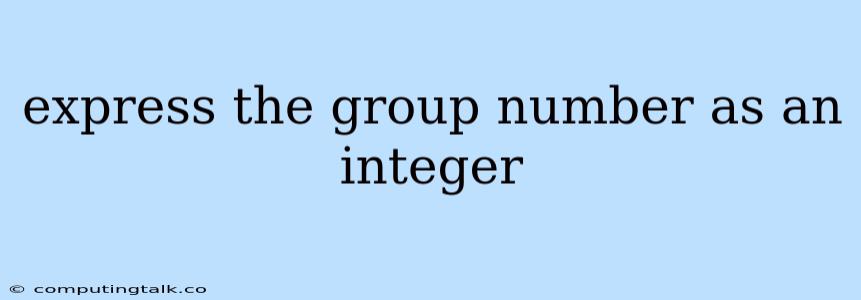Expressing a group number as an integer is a common task in programming and data analysis. It involves converting a string or textual representation of a group number into a numerical value. This process is essential for various operations, such as sorting, filtering, and performing mathematical calculations on groups. This article will explore different methods and scenarios where you might encounter this requirement, along with practical examples and tips for handling group numbers effectively.
Why Express Group Numbers as Integers?
Before diving into the methods, let's understand why expressing group numbers as integers is crucial. Consider a scenario where you have a dataset containing information about different customer groups. The group names might be represented as strings like "Group A," "Group B," "Group C," and so on.
If you want to sort these groups based on their numerical order, you need to convert the group names into integers. This is because sorting algorithms typically work with numerical values, and directly comparing strings "Group A" and "Group B" would not provide the desired outcome.
Methods for Expressing Group Numbers as Integers
Several methods can be employed to express group numbers as integers, depending on the specific context and programming language you are using. Here are some common approaches:
1. Manual Mapping
One straightforward method is to manually create a mapping between group names and corresponding integer values. This approach is suitable when you have a limited number of groups and the mapping is straightforward.
Example:
group_mapping = {
"Group A": 1,
"Group B": 2,
"Group C": 3
}
group_name = "Group B"
group_number = group_mapping[group_name] # group_number will be 2
2. Regular Expressions
If the group names follow a consistent pattern, you can leverage regular expressions to extract the numerical part of the group name and convert it to an integer.
Example:
import re
group_name = "Group 5"
group_number = int(re.findall(r'\d+', group_name)[0]) # group_number will be 5
3. String Manipulation
In some cases, you might be able to extract the numerical part of the group name using string manipulation techniques. For instance, if the group name always starts with "Group" followed by a space and a number, you can split the string and convert the extracted number to an integer.
Example:
group_name = "Group 10"
group_number = int(group_name.split(" ")[1]) # group_number will be 10
4. Libraries and Functions
Many programming languages provide libraries and functions that simplify the process of converting strings to integers. For instance, Python's int() function can directly convert a string representing an integer to its numerical equivalent.
Example:
group_name = "Group 20"
group_number = int(group_name[6:]) # group_number will be 20
Considerations and Best Practices
When expressing group numbers as integers, consider the following factors:
- Uniqueness: Ensure that each group number is unique to avoid ambiguity and potential errors.
- Consistency: Maintain a consistent approach to assigning and converting group numbers across your data and systems.
- Data Type: Choose the appropriate integer data type (e.g.,
int,long) based on the range of group numbers you are working with. - Error Handling: Implement appropriate error handling mechanisms to catch potential errors during the conversion process (e.g., invalid group names, non-numeric characters).
Conclusion
Expressing group numbers as integers is a common practice in data manipulation and analysis. Choosing the appropriate method depends on the specific context and the format of your group names. By following the methods and best practices outlined above, you can efficiently convert group numbers into integers, enabling seamless operations and data processing.
